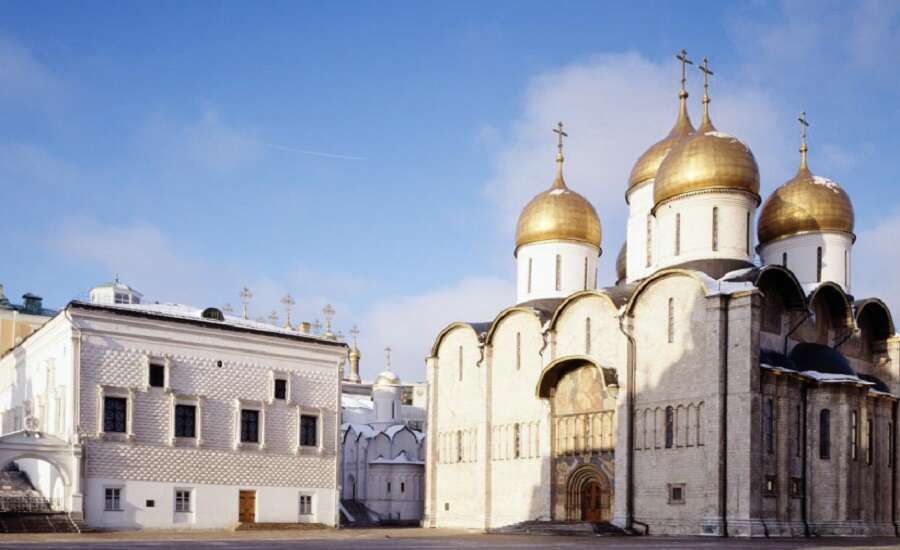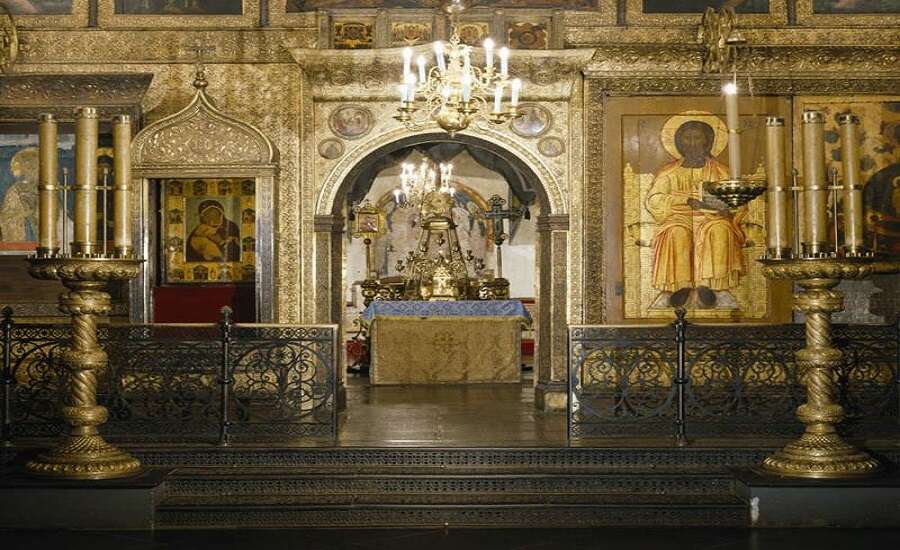The first stone cathedral was laid on this site in 1326, by the Moscow Metropolitan Peter and Grand Duke Ivan I. In the late 14th century Ivan III, as part of his reconstruction of the Moscow Kremlin, ordered the new Assumption Cathedral (Uspensky Cathedral) to be built. It was erected by Italian architect Aristotle Fioravanti between 1475 and 1479, using the latest technologies to ensure the cathedral’s great size and stability.
For the next four centuries, the Assumption Cathedral was the religious centre of Russia. It was the setting for events of national significance, such as coronations of Russia’s Princes and Tsars, inaugurations of Metropolitans and Patriarchs, services to bless upcoming military campaigns and military victories, and the announcement of important public acts. From the 14th to 17th centuries the heads of the Russian Orthodox Church were laid to rest in the Assumption Cathedral. Although the majority of royal weddings were held in the Annunciation Cathedral (the personal chapel of the royal family), the most important weddings took place in the Assumption Cathedral
Did you know? The activities of the Assumption Cathedral marked the new independence of the Russian Orthodox Church. Previously, Metropolitans had to travel to Constantinople to be ordained, and Russia’s first Patriarch, Job, was appointed here.
As with the other cathedrals on the Kremlin’s Cathedral Square, the Assumption Cathedral was looted by the Polish-Lithuanian armies and Napoleon’s army in 1612 and 1812, and suffered fire damage numerous times over the centuries.
Following the October Revolution of 1917, the Assumption Cathedral was turned into a museum. Lenin personally allowed one last Easter service to be held in 1918, and services did not recommence until 1990. Thanks to restoration work undertaken during the Soviet period, the cathedral’s magnificent interior was extremely well preserved.
Did you know? The Assumption Cathedral is unique in all but name - there are over 30 churches in Russia which share the same name!

Photo from https://assumption-cathedral.kreml.ru/
The stately Assumption Cathedral was modelled on the Dormition Cathedral in Vladimir, one of the Golden Ring cities of Ancient Russia, and its design merges Ancient Russian religious architecture with Renaissance elements. Although the Assumption Cathedral is not as ornate as the Kremlin’s other cathedrals, it is a fascinating sight nonetheless. Five gilded domes crown its roof, representing Jesus and the Four Evangelists, and mirroring the silver domes of the Church of the Twelve Apostles which stands adjacent.
Did you know? The belfry of the Assumption Cathedral holds the largest ringing bell in Moscow! The Bolshoi Uspensky Bell (Big Assumption Bell) weighs 62.5 tons. The largest bell in the world, the Tsar Bell, stands nearby on Cathedral Square.
Because of the importance that the Assumption Cathedral held in the Russian state, particular attention was paid to the decoration of its interior, and outstanding examples of Russian art cover the walls from floor to ceiling. Its frescos and icons are artworks of international artistic value, and the cathedral is also home to the oldest surviving fresco in the Kremlin. The dome murals depict images of God, the pillars are decorated with Christian martyrs, and different sections of the walls are dedicated to scenes from the Gospel, from the life of the Virgin Mary, and the Seven Ecumenical Councils who played a founding role in Christian Orthodox history. As well as paintings, visitors can admire skilful woodwork, metalwork, and ornate chandeliers.

Photo from https://assumption-cathedral.kreml.ru/
The grand five-tiered iconostasis was created in 1653 and covers one entire wall of the cathedral, rising from floor to ceiling with icons painted by medieval Russian masters. In front of the iconostasis lay the Tsar, Tsarina and Patriarch’s praying-seats, which sit under richly carved marquees. Along the walls lie reliquaries and the tombs of Russia’s Metropolitans and Patriarchs, dating from the 14th to 18th centuries.
Address and contact details
Sobornaya Ploshchad, Moscow Kremlin, Moscow, 103132
Tel: +7 (495) 695-46-31 (ticket bureau)
Website: https://assumption-cathedral.kreml.ru/
Nearest metro: Biblioteka Imeni Lenina/Alexandrovsky Sad/Borovitskaya (550m)
Opening hours
From 15th May to 30th September - 9:30 to 18:00, from 1st October to 14th May - 10:00 to 17:00. Closed on Thursdays.
Ticket price to visit the Cathedral Square ensemble, including the Assumption Cathedral, is 700 roubles.
Join us on Facebook
We invite you to become a fan of our company on Facebook and read Russian news and travel stories. To become a fan, click here.
Join our own Russian Travel, Culture and Literature Club on Facebook. The club was created to be a place for everyone with an interest in Russia to get to know each other and share experiences, stories, pictures and advice. To join our club, please follow this link.